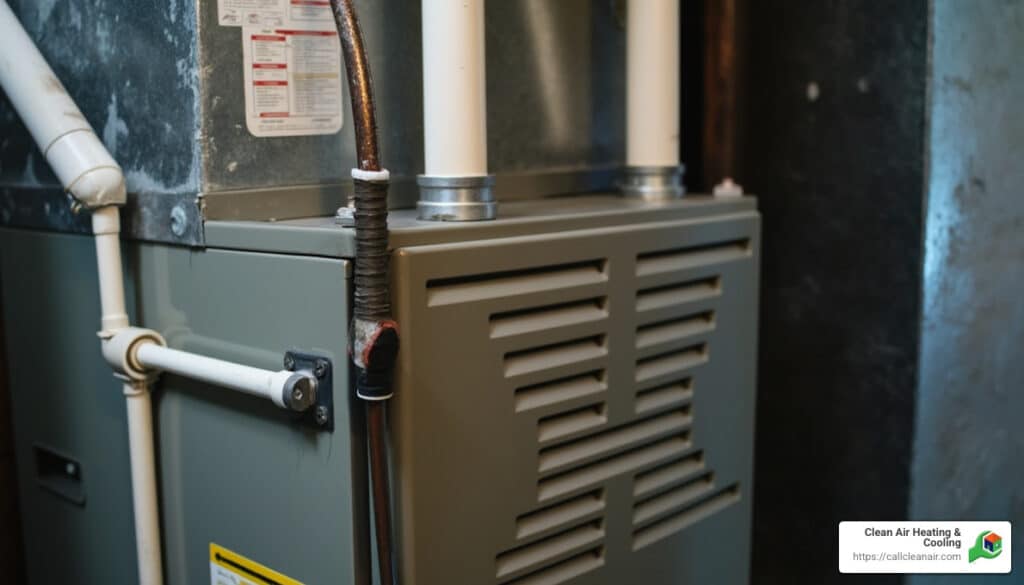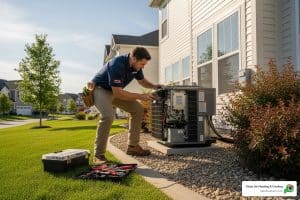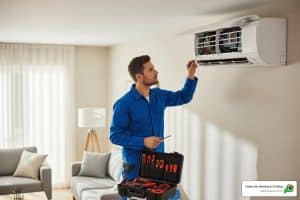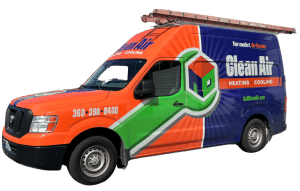Furnace repair cost estimate is a concern for homeowners, especially in cold climates where a functioning furnace is essential. Homeowners often face challenges with their heating systems, and understanding repair costs can help avoid unexpected expenses. Here’s a quick guide to what impacts these costs:
- Type of repair: Different parts break at different rates and costs. Identifying the problem will guide the estimate.
- Labor costs: These can vary based on location and service provider.
- Part replacement: Some parts are more expensive than others to replace.
- While regular maintenance can limit costs, recognizing common furnace issues is key to avoiding larger expenses.
As someone who has led Clean Air Heating & Cooling, my experience in the HVAC industry allows me to offer insights into furnace repair cost estimate. My expertise helps ensure you get accurate, efficient, and cost-effective solutions for your heating needs.

Furnace repair cost estimate further reading:
– Bellingham heat pump repair
– Furnace maintenance checklist
Understanding Furnace Repair Costs
Furnace Repair Cost Estimate
Furnace repairs can be a significant concern for homeowners, especially in colder climates. Knowing the furnace repair cost estimate can help you budget and avoid surprises. The national average for furnace repairs typically ranges from $300 to $1,200. However, the exact cost can vary widely based on several factors.
Repair Types: Simple repairs like replacing a thermostat or fixing an ignitor might be on the lower end of the scale. More complex issues, such as a cracked heat exchanger, can push costs to the higher end.
Labor Costs: Labor is a crucial component of repair costs. Depending on your location, labor can be more expensive. For example, urban areas might have higher labor rates compared to rural regions.
Factors Influencing Costs
Several factors influence the cost of furnace repairs, making it essential to understand what might affect your particular situation.
Furnace Type: The type of furnace you own—whether it’s electric, gas, oil, or propane—can impact repair costs. Electric furnaces often have fewer moving parts and may be cheaper to fix, while oil furnaces might require more expensive maintenance due to soot buildup.
Repair Type: The specific part that needs repair or replacement significantly affects the cost. For instance, replacing a flame sensor is generally cheaper than fixing a heat exchanger.
Geographic Location: Your location can affect both the availability of parts and the cost of labor. Areas with harsher climates might have higher demand for HVAC services, potentially increasing costs.
Understanding these factors can help you anticipate and manage repair costs better. Regular maintenance and awareness of common issues can also reduce the likelihood of expensive repairs.

Common Furnace Repair Issues
When it comes to maintaining your furnace, understanding common issues can save you both time and money. Let’s explore some of the typical problems you might encounter.
Ignitor Problems
The ignitor is a crucial component that lights the burners in your furnace. Unfortunately, ignitor malfunctions are quite common. Dirt and grime build-up can damage the ignitor, leading to a breakdown. If your furnace isn’t producing heat, the ignitor might be the culprit.
Replacing an ignitor typically costs between $300 to $400. Regular maintenance can help prevent these issues by keeping the ignitor clean and functional.
Thermostat Malfunctions
A faulty thermostat can leave you shivering in the cold or sweating in the heat. Often, homeowners mistakenly think their furnace is broken when the thermostat is the real issue.
Thermostat replacement costs vary widely. A basic manual thermostat might cost around $20, whereas a smart thermostat could set you back $200 or more. Smart thermostats offer more control and efficiency, making them a worthwhile investment for many.
Flame Sensor Issues
The flame sensor is a safety feature that ensures the burners are lit. If it gets too dirty, it can’t detect the flame, causing the furnace to shut down. This is not just inconvenient but can also pose safety concerns, as a faulty flame sensor might allow gas to accumulate.
Replacing a flame sensor is generally less costly, ranging from $80 to $250. Regular cleaning during annual maintenance can help avoid these problems and keep your furnace running smoothly.

Understanding these common issues can help you take preventative measures, ensuring your furnace runs efficiently throughout the colder months. Next, we’ll explore when it might be more cost-effective to repair your furnace versus replacing it altogether.
Repair vs. Replacement
Deciding between repairing or replacing your furnace can be tricky. Here’s what you need to know to make the best choice for your home and wallet.
When to Repair
If your furnace is relatively young and only has minor issues, repair is often the best option. Most furnaces have a lifespan of 15 to 25 years. If your furnace is within this range and hasn’t had frequent breakdowns, a simple repair might be all you need.
Minor issues like a faulty ignitor or a thermostat malfunction are usually affordable to fix. Regular maintenance can extend the life of your furnace, keeping it efficient and reducing the need for costly repairs.
Quick Tip: If the repair cost is less than 50% of the replacement cost, it usually makes sense to repair.
When to Replace
Sometimes, replacing your furnace is the smarter financial decision. If your furnace is nearing the end of its lifespan or if you’re experiencing frequent breakdowns, replacement might be more cost-effective in the long run.
The $5,000 Rule can help guide your decision. Multiply the age of your furnace by the estimated repair cost. If the result is more than $5,000, consider replacing the furnace. For example, a 20-year-old furnace with a $300 repair estimate would hit $6,000, suggesting replacement might be wise.
Frequent repairs can add up quickly, and a new furnace can offer better energy efficiency, saving you money on utility bills. Plus, newer models often come with improved features and longer warranties.
Consider This: If your furnace repair costs exceed 50% of the cost of a new furnace and it’s over 15 years old, it’s time to think about replacement.
Understanding when to repair or replace your furnace can save you from unexpected expenses and ensure your home stays warm and comfortable. Up next, we’ll tackle some frequently asked questions about furnace repair costs.
Frequently Asked Questions about Furnace Repair Costs
What is the average cost of a furnace repair?
The cost of repairing a furnace can vary widely. On a national scale, the average repair costs for a furnace range from small fixes to more substantial repairs. For electric furnaces, you might expect to pay less, while gas or oil furnaces can be pricier due to their complexity.
The typical price range for a repair spans from a few hundred dollars to over a thousand, depending on the issue. Always get a detailed estimate from your HVAC technician to understand what you’re paying for.
What is the most expensive part to fix on a furnace?
One of the costliest parts to repair or replace in a furnace is the heat exchanger. This component is crucial for heating your home, as it transfers heat generated by the burners to the air circulated by the blower.
Replacing a heat exchanger can be expensive due to the labor costs involved. The process is complex and time-consuming, requiring skilled technicians to ensure it’s done correctly. If your heat exchanger is damaged, it might be worth considering whether a full furnace replacement is more economical, especially if your unit is older.
How can I save on furnace repair costs?
- Regular Maintenance: Routine maintenance is key. Schedule regular check-ups with a professional to catch minor issues before they become major repairs. This can extend the life of your furnace and keep it running efficiently.
- Service Agreements: Consider signing up for a service agreement with your HVAC provider. These agreements often include regular maintenance visits and can offer discounts on parts and labor, saving you money in the long run.
- DIY Basics: Simple tasks like regularly changing your furnace filter can prevent dust buildup, which can strain the system and lead to costly repairs.
- Smart Upgrades: Investing in a programmable thermostat can optimize your furnace’s efficiency, potentially reducing your energy bills and wear on the system.
By understanding these factors, you can better manage your furnace repair costs and keep your home warm without breaking the bank. Next, we’ll dig into more ways to ensure your furnace operates efficiently year-round.
Conclusion
At Clean Air Heating & Cooling, we prioritize your comfort and satisfaction. We understand that furnace repairs can be stressful, but our team is here to make the process as smooth as possible. With our commitment to customer satisfaction, we ensure that every repair is handled with care and precision. Our skilled technicians work diligently to get your furnace up and running quickly, minimizing any inconvenience to your daily routine.
Our unique utility savings guarantee is designed to give you peace of mind. By choosing us, you can expect to save significantly on your utility bills. We are committed to delivering high-quality service that not only solves your immediate furnace issues but also improves the overall efficiency of your heating system.
If you are in Northwest Washington, including Whatcom, Skagit, Snohomish, or San Juan Counties, trust Clean Air Heating & Cooling for all your HVAC needs. We are dedicated to providing prompt, reliable service with a focus on your satisfaction. With over 480 5-star Google reviews, our reputation speaks for itself.
For more information or to schedule a service, visit our Furnace Services page. Let us help you stay warm and comfortable all year round.





